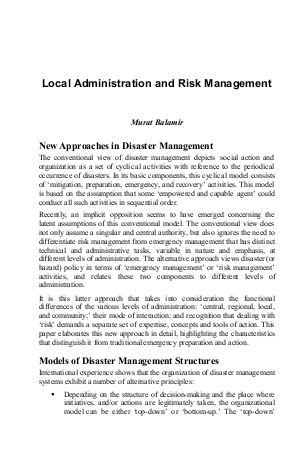
The conventional view of disaster management depicts social action and organization as a set of cyclic al activities with reference to the periodical occurrence of disasters. In its basic components, this cyclic al model consists of ‘mitigation, preparation, emergency, and recovery’ activities. This model is based on the assumption that some ‘empowered and capable agent’ could conduct all such activities in sequential order.
Recently, an implicit opposition seems to have emerged concerning the latent assumptions of this conventional model. The conventional view does not only assume a singular and central authority, but also ignores the need to differentiate risk management from emergency management that has distinct technical and administrative tasks, variable in nature and emphasis, at different levels of administration. The alternative approach views disaster (or hazard) policy in terms of ‘emergency management’ or ‘risk management’ activities, and relates these two components to different levels of administration.
It is this latter approach that takes into consideration the functional differences of the various levels of administration: ‘central, regional, local, and community;’ their mode of interaction; and recognition that dealing with ‘risk’ demands a separate set of expertise, concepts and tools of action. This paper elaborates this new approach in detail, highlighting the characteristics that distinguish it from traditional emergency preparation and action.
Resource collections
- UN Habitat - Urban Response Collection
- Urban Response - Urban Crisis Preparedness and Risk Reduction
- Urban Response Collection - Community Engagement and Social Cohesion
- Urban Response Collection - Economic Recovery
- Urban Response Collection - Environment and Climate Change
- Urban Response Collection - Housing, Land and Property
- Urban Response Collection - Urban Crisis Response, Recovery and Reconstruction
- Urban Response Collection - Urban Resilience
